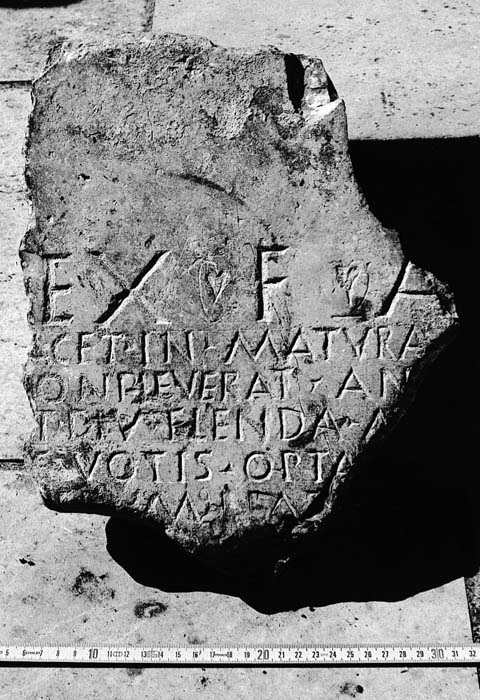Funerary inscription
Reference CIL II2/5, 61a | Description | Lyrics | Location | Chronology | Epigraphic edition | Translation | Apparatus | Comentary | Type of verse | Text divided into verses and metric signs | Images | Bibliography | Link to DB | Author |
Funerary inscription
Description
- Idno filename 22/01/0087
- Type of inscription: Sepulcralis
- Conservation status: Rotated on the left, right and lower sides. Part of the irregular upper edge is preserved.
- Dimensions height/width/depth (cm): 34/26/5.5
-
Epigraphic field:
- Layout: The fragment corresponds to the right side. Guidelines. Interpunction signs: l. 1 rather rough hederae. Triangles in the carmen.
- Epigraphic field execution: The epigraphical surface is damaged.
- Preserved
Lyrics
- Font:Capital rústica
- Description of the letters:Large roughly executed letters in the praescriptum (l. 1: 4.3); carmen with smaller, almost regular, letters (l. 2: 2; ll. 3-6: 1.8). In l. 3 smaller E almost on top of the L.
Location
- Place of discovery: Found in 1954 in the estate of Mingo Lope, Cañada de Algarrobo, about 4.5 km from Escañuela, in the direction of the old road to Torredelcampo (Jaén).
- Geolocation
- Conservation location: Kept in the Museo Provincial in Jaén.
- Location with Modern Nomenclature España / Jaén / Torredelcampo
- Location with Old Nomenclature Hispania / Baetica / Astigitanus
Chronology
- Inscription's dating: The year 0
Type of verse
- Type of verse: Dactílico (hexámetro)
- Verse/line correspondence: Si
- Prose/verse distinction: Si
Epigraphic edition
[‑ ‑ ‑S]ex(ti) ❦ f(ilia) ❦ a[‑ ‑ ‑]
[‑ ‑ ‑i]acet ▴ in▴matura [‑ ‑ ‑]
[‑ ‑ ‑c]onpleverat ▴ an[nos‑ ‑ ‑]
[‑ ‑ ‑]t ▴ diu ▴ flenda ▴ m[arito]
5 [‑ ‑ ‑]e ▴ votis ▴ opta[‑ ‑ ‑]
[‑ ‑ ‑it]erum ? ▴ nam[‑ ‑ ‑]
‑ ‑ ‑ ‑ ‑ ‑
Text divided into verses and metric signs
[- – – i]acet inmatura [- – -] [ln|ln|l]/kk|ll|lk[k|l~]
[‑ ‑ ‑ c]onpleverat an[nos] [ln|ln|ln|l]/l|lkk|l[~]
[‑ ‑ ‑]t diu flenda m[arito] [ln|ln|ln|l]/l|lk[k|l~]
[‑ ‑ ‑qua]e votis opta[‑ ‑ ‑] [ln|ln|l]/l|l/l|l[kk|l~]
5 [‑ ‑ ‑it]erum nam[‑ ‑ ‑] [ln|ln|l]/kk|l/l|[lkk|l~]
– – – – – –
Translation
?, daughter of Sextus. [---] [---] lies, [---] who had not reached maturity. [---] had completed [---]
Bibliography
Stylow, II2/5, 61a (inde HEp 2002, 313); del Hoyo in Fernández Martínez, CLEB J18 cum im. phot. (inde HEp 2010, 449); Cugusi 2012, 38.
Apparatus
2 [hic sita in tumulo i]acet in · matura [puella] Stylow, expleri potest ex CLE 1245, 1 bis senos vitae qui [vix compleverat annos]. – 2 [bis denos vitae quae vix c]ompleverat · an[nos] supp. Stylow. – 4 flenda · m[arito] Stylow; [—obi]t Cugusi. – 5 [—qua]e Stylow. – 6 [—it]erum (?) Stylow.
Comentary
Dactylic rhythm, possibly hexameters rather than distichs to judge by the second verse, with line-verse correspondence. The reconstructions proposed by Stylow would give a first hexameter with penthemimers, but with a hiatus in sita in. Hic sita and iacet mean the same thing and it does not seem likely that they would occur in the same verse. The latter is the final clausula of a hexameter.
Etymological separation in matura, even marked with an interpunction. In l. 3 conpleverat por compleverat. From the third verse it is possible to develop the topos of the eternal grief that the death of a family member leaves behind, an argument found in other carmina in Hispania (cf. CLE 445). The fourth verse may reflect the idea of the prayers of the parents for their daughter, unfulfilled because of her death at an early age (cf. II2/7,737: [—] s totius dare vota fuerunt), or the parents’ prayers to die before their daughter.
Author
- Author:J. Del Hoyo Calleja
- Last Update2024-02-17 18:28:10
- Autopsy date:2000
You can download this






